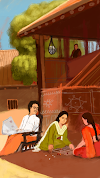Exploring Australian Cuisine: Recipes, Snacks, and Unique Food Habits
Australian cuisine is a melting pot of flavors influenced by its Indigenous heritage and the diverse cultures of immigrants. From the simplicity of a Vegemite toast to the sophistication of a Barramundi fillet, Australia offers a rich culinary experience that caters to all tastes. Let’s dive into what makes Australian food unique and how you can recreate it at home!
Why Is Australian Food Unique?
Australian food is distinct because it combines Indigenous ingredients like wattleseed, kangaroo, and bush tomatoes with international flavors brought by European, Asian, and Middle Eastern influences. The emphasis on fresh, locally sourced ingredients further sets it apart.
Easy Australian Recipes to Try
- Vegemite Toast: Spread a thin layer of Vegemite on buttered toast. It’s an acquired taste but a must-try for anyone exploring Australian cuisine.
- Lamingtons: These are sponge cakes coated in chocolate and desiccated coconut. Perfect for beginners.
- Smashed Avocado: Mash ripe avocado with lemon juice, salt, and pepper. Serve on toast, often topped with poached eggs.
Intermediate Australian Recipes
- Barramundi Fillet: Pan-fry this mild, flaky fish with lemon butter sauce for a delightful main course.
- Meat Pies: Make a flaky pastry filled with minced meat, onion, and gravy. A quintessential Aussie snack!
- ANZAC Biscuits: Mix oats, coconut, and golden syrup to bake these historical cookies.
Challenging Australian Recipes
- Pavlova: A meringue-based dessert topped with whipped cream and fresh fruits. Achieving the perfect texture requires practice.
- Kangaroo Steak: Cook this lean meat to medium-rare for the best flavor. It’s a sustainable and healthy option.
- Damper Bread: Traditionally cooked over a campfire, this soda bread requires skill to get the perfect texture.
Popular Australian Snacks
- Tim Tams: Iconic chocolate biscuits loved by all.
- Fairy Bread: White bread with butter and colorful sprinkles – a party favorite.
- Chiko Rolls: A deep-fried snack filled with meat and veggies, inspired by Chinese spring rolls.
Occasional Foods and Festive Dishes
Australian celebrations often feature unique dishes:
- Christmas: Seafood platters, cold meats, and pavlova are common during the summer holiday season.
- Australia Day: BBQ sausages, lamb chops, and lamingtons are the highlights.
- Easter: Hot cross buns and chocolate bilbies (instead of Easter bunnies) are traditional treats.
Drinks and Beverages
- Flat White: An Australian-style coffee that’s similar to a latte but with less foam.
- Bundaberg Ginger Beer: A non-alcoholic beverage with a spicy kick.
- Australian Wines: Shiraz and Chardonnay are world-famous, thanks to regions like Barossa Valley and Hunter Valley.
Tips for Cooking Australian Dishes
- Use fresh, seasonal ingredients whenever possible.
- Don’t be afraid to experiment with native Australian spices like wattleseed and lemon myrtle.
- Balance simplicity with flavor – many Australian dishes emphasize natural tastes.
Q: What’s bush tucker, and how is it different from regular Australian food?
Answer: Bush tucker refers to the traditional foods of Indigenous Australians, including native plants, fruits, and animals. It’s different because it highlights sustainable, natural ingredients like kangaroo, emu, bush tomatoes, and finger limes, often used in innovative modern recipes.
Q: Are there any unusual ingredients or spices unique to Australian cooking?
Answer: Yes! Wattleseed is a versatile ingredient with a nutty, coffee-like flavor. Lemon myrtle is another unique spice with a zesty, citrusy taste. These are often used in desserts, teas, or even as marinades for meats.
Q: I’ve heard about the famous Aussie barbecue. What makes it so special?
Answer: Australian barbecues, or "barbies," are all about fresh ingredients and a relaxed vibe. Common items include sausages (snags), prawns, lamb chops, and steaks, often paired with salads and a cold beer. It’s more than food; it’s a social event!
Q: What are some quick and easy Australian snacks I can try making at home?
Answer: Try fairy bread (bread with butter and sprinkles), Anzac biscuits (oat cookies), or Vegemite on toast. They’re simple, iconic, and delicious!
Q: What’s Vegemite, and why is it so popular in Australia?
Answer: Vegemite is a savory spread made from brewer’s yeast extract. It’s salty, umami-rich, and loved for its unique flavor. Australians often eat it on toast with butter. It’s an acquired taste for many visitors!
Q: Are there any famous regional dishes across Australia?
Answer: Absolutely! South Australia is known for its pie floater (a meat pie served in pea soup). Tasmania offers fresh seafood like oysters and abalone. Queensland is famous for Moreton Bay bugs (a type of lobster), and Victoria loves its dim sims (steamed or fried dumplings).
Q: What about drinks? Any uniquely Australian beverages?
Answer: For sure! Australians love flat whites (a creamy coffee). There’s also Bundaberg ginger beer, and for alcoholic drinks, Foster’s beer and Australian wines, particularly Shiraz and Chardonnay, are internationally renowned.
Q: What’s the dessert scene like in Australia?
Answer: Desserts are amazing! Pavlova is a must-try meringue dessert topped with fruits and cream. Lamingtons are sponge cakes coated in chocolate and coconut. Tim Tams, a type of chocolate biscuit, are perfect for snacking.
Q: If I wanted to try making an Australian dinner at home, what should I cook?
Answer: Start with a grilled kangaroo steak or lamb chops. Pair it with roasted vegetables or a beetroot salad. For dessert, whip up a pavlova or some lamingtons. It’s a classic Aussie experience!
Q: Are there any food customs or etiquettes I should know about if I visit Australia?
Answer: Australians are laid-back about food, but sharing is key, especially at barbecues. Don’t forget to bring a dish or drinks if you’re invited to someone’s home. Also, avoid making large servings of Vegemite if you’re new to it!
Q: Are there any foods or ingredients Australians have adopted from other cultures?
Answer: Yes, Australian cuisine is heavily influenced by Italian, Greek, and Asian cultures. Dishes like spaghetti bolognese, sushi, and Thai curries are incredibly popular. The fusion of flavors makes the food scene exciting!
Q: What are some unique ways Australians celebrate food during festivals or holidays?
Answer: On Australia Day, barbecues and lamingtons are staples. Christmas often includes cold seafood platters and fruit salads, given the summer heat. Easter brings out hot cross buns, and ANZAC Day features traditional ANZAC biscuits.
Q: Are there any challenging Australian recipes worth trying?
Answer: Yes! Making a proper pavlova can be tricky as it requires precision to get the meringue just right. Another challenge is perfecting the dough for damper bread, a traditional campfire bread.
Q: How does Australian food reflect its multicultural population?
Answer: The diversity is evident in the food! You’ll find Middle Eastern kebabs, Chinese dumplings, and Indian curries alongside traditional Aussie dishes. It’s a culinary melting pot that caters to all tastes.
Conclusion
Australian cuisine is as vast and varied as its landscapes. Whether you’re looking for easy snacks or challenging recipes, there’s something for everyone to enjoy. By exploring these dishes, you’ll not only satisfy your taste buds but also gain a deeper appreciation for Australian culture and its rich culinary heritage.


















0 Comments